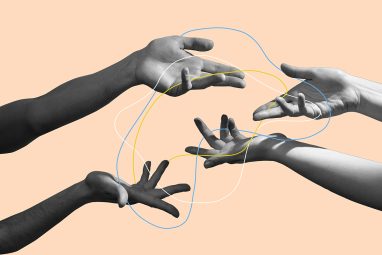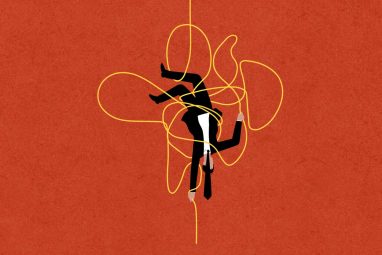Bed Bath & Bankruptcy: Lessons for Senior Leaders
Research reveals that a focus on finances is no substitute for creating customer value when a company is struggling.
Topics
The Strategy of Change
News
- Only 2% of Global Organizations Ready to Scale AI Securely, New Report Reveals
- Here’s How TCS and MIT SMR Aim to Redefine the Future of Enterprise AI
- How UAE Leaders Are Redefining AI’s Role Across Business and Society
- Ultra-High-Capacity Storage Is Becoming the Backbone of AI Ambitions in the GCC
- Private Sector to Outpace Governments in $20 Billion Earth Intelligence Market
- Saudi Arabia to Add 112MW to Data Centre Capacity in New Deal

Bed Bath & Beyond (BB&B) finally filed for bankruptcy on April 23, 2023, after surviving a near-death experience earlier in the year thanks to a last-minute equity infusion from an opportunistic investor. The termination of that agreement and the subsequent failure to raise sufficient capital through new share issuance and other financing techniques meant that the company had exhausted the capacity of creative financial engineering to stay in business.
The financially focused strategy initiated by a new management team installed in 2019 ultimately couldn’t save the struggling retailer. To diagnose why their approach was so misguided and what lessons senior leaders should learn, we surveyed more than 1,600 retail shoppers in the months before BB&B declared bankruptcy.
The arc of the BB&B story is a familiar one: An innovator enjoys spectacular market success but fails to respond adequately to subsequent changes in the competitive environment. This leads to flatlining growth followed by revenue declines and operating losses. Newly appointed leadership relies on financial engineering to bolster the share price by cutting many of the costs involved in creating the distinctive appeal of the business. Ultimately, the business is acquired or fails.
Looking Back at a Storied Brand
BB&B emerged when its founders spotted the opportunity for a specialty retailer to take market share from department stores by offering a breadth of selection and a shopping experience that the latter could not match.
Retailers that embraced this model, colloquially known as category killers, enjoyed spectacular initial success across multiple product groups, including toys at Toys “R” Us, household electronics at Circuit City, and sports equipment at Sports Authority.
Unlike these other specialty retailers, Bed ’n Bath — the original moniker when the company launched in 1971 — came to recognize that its appeal was based on a type of shopping experience rather than the specific merchandise assortment of its earliest stores. The company understood that the appeal of designer brands extended across multiple household categories beyond bedding, allowing it to create a differentiated shopping experience by expanding its product selection and increasing the size of its stores. This evolution prompted the 1987 adoption of the new company name of Bed Bath & Beyond.
The value proposition of Bed Bath & Beyond as a destination for things that you didn’t realize you wanted was reinforced by an innovative coupon strategy. Rather than offering a loss-leader discount on a single high-demand item (as was the norm among retailers at the time), BB&B’s coupons could be applied to any item, ensuring that shoppers felt that there was always the opportunity for a bargain. In addition, store managers were given considerable autonomy over which products to stock, allowing them to adapt their merchandise assortments to appeal to their local markets and ensuring that each store represented a unique shopping experience. “You never know exactly what you are going to find at BB&B” was one of the most common observations among our survey respondents.
The seeds of BB&B’s woes were sown in its failure to respond to the emerging e-commerce threat from Amazon and other retailers. This oversight overlapped with the competitive response from other brick-and-mortar retailers, most notably HomeGoods, Target, and Costco: providing a shopping experience that combined attractive prices on basic necessities (“triggers,” in Costco’s terminology) with the possibility of finding unexpected “treasures” (also Costco’s term).
The seeds of BB&B’s woes were sown in its failure to respond to the emerging e-commerce threat from Amazon and other retailers.
BB&B’s trailing 12-month revenues reached $10.9 billion in February 2013 but were only marginally higher, at $12.0 billion, in February 2019, despite a 35% increase in new store openings (from 1,130 to 1,530 locations) and a commensurate rise in employee head count (from 48,000 to 65,000). Operating income collapsed from a robust $1.6 billion in February 2013 to a small loss in February 2019, triggering the replacement of the CEO and the adoption of a dramatic strategy by his successor, a former senior executive at Target.
Understanding the Core Issue: Consumer Value Creation
The engine of sustainable business success is customer value creation. A core tenet of leadership is that value must be created before it can be captured. This means it is critical for leaders to understand what is driving its relevance to its customers and what the sources of its distinctiveness are.
In our article “Changing How We Think About Change,” we described fit to purpose as a way to evaluate the size of the market that a business can serve, while relative advantage evaluates the opportunity for pricing power and margin. For sustained success, a business needs both scale and margin — and neither should be pursued without explicit consideration of its impact on the other.
Viewed through this lens, the new leadership team might have described the company’s history in terms of four eras:
- 1971-1985: BB&B pioneers the category killer concept in bedding, establishing fit to purpose and a distinctive relative advantage based on a broad selection and attractive pricing through its innovative coupon strategy.
- 1985-2013: BB&B further drives fit to purpose by expanding into other product categories and opening more than 1,100 new stores. It enjoys high but declining relative advantage as other physical retailers (most notably HomeGoods, founded in 1992) create competitively similar store offerings. Meanwhile, online alternatives emerge in the form of Amazon and new entrants (most notably Wayfair, founded in 2002).
- 2013-2019: BB&B pursues fit-to-purpose maximization through continued store openings, peaking at a total of more than 1,500 locations in 2018, but it falls short in developing an adequate online presence. It appears to ignore the erosion of its relative advantage due to increased physical and online competition that undermine its operating margins.
- 2019: Pressure from activist investors results in the appointment of a new management team that enjoys considerable latitude regarding the choices they could make in terms of fit to purpose and relative advantage.
Sadly, the new leadership team saw its priorities in narrowly financial terms rather than in terms of optimizing the fit to purpose and relative advantage of the business. Thus, they chose a strategy focused largely on cost cutting. While closing underperforming stores was essential, the team also chose to substitute private-label products for nationally recognized brands and sharply curtailed distribution of the retailer’s hugely popular 20% off coupons. These latter moves (which no doubt seemed sensible from a purely financial perspective) resulted in the elimination of the very things that gave BB&B its distinctive appeal in the hotly contested retail environment. At the same time, they still failed to address the company’s lagging online presence.
The team compounded these strategic missteps by using the proceeds from the sale of 2 million square feet of its retail space — involving additional closures beyond the worst-performing stores — to fund a stock buyback program. Fewer store locations meant that BB&B simultaneously became less accessible to its customers and lacked the resources to respond to the COVID-19 pandemic as effectively as retailers that more nimbly pivoted to online shopping and “buy online, pick up in store” strategies. Consequently, BB&B largely missed out on the booming demand for household products during the pandemic. Tellingly, comments from our survey respondents included “Amazon has usurped them for my shopping needs” and “If there was no Wayfair, I would shop [at BB&B] more often.”
Company leadership failed to understand that the real strategic challenge was to restore the relevance of BB&B to the types of customers it was best able to serve (fit to purpose) and find ways to reestablish the opportunity for margin through distinctiveness (relative advantage). They squandered the opportunity for reinvention and, by propping up the share price through stock buybacks, starved the business of the resources required to build on the considerable base of shopper goodwill it had created.
Temporary support for the share price was provided by BB&B’s status as one of the pandemic meme stocks. (GameStop and AMC also enjoyed massive support from amateur investors who famously caused losses to be incurred by short sellers of these stocks.) However, the continuing slide in operating performance and pressure from activist investors resulted in the appointment of new leadership in June 2022.
But it was too late to turn the business around. Despite a massive and ongoing store closure program and severe staff reductions, by February 2023 the company was within days of filing for bankruptcy — a fate it avoided only by accepting an equity infusion on onerous terms.
If They Could Turn Back Time
Fit to purpose and relative advantage analysis could have informed BB&B’s leadership about the shopper types that the retailer was best positioned to serve. In our article “As Stores Reopen, Which Customers Are Most Likely to Return?,” we identified five main shopper types. In brief, they are:
- Functional: “I think of shopping as a necessary task.”
- Tactile: “I like to see and touch products before I buy them.”
- Experiential: “I like making shopping social and enjoyable.”
- Reluctant: “I prefer to avoid physical stores and like the convenience of shopping online.”
- Diversionary: “I view shopping as an excuse to get out of the house.”
Using this framework among the 1,600-plus shoppers we surveyed, we established the size of the five shopper segments, the frequency with which each segment shopped at BB&B, and their specific reasons for doing so, as shown in the table “Who Shopped at Bed Bath & Beyond and Why.”





